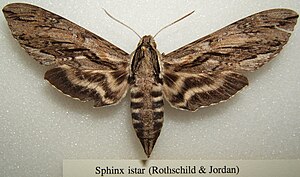Lintneria istar
| Lintneria istar | ||||||||||||
|---|---|---|---|---|---|---|---|---|---|---|---|---|

Lintneria istar (preparation) |
||||||||||||
| Systematics | ||||||||||||
|
||||||||||||
| Scientific name | ||||||||||||
| Lintneria istar | ||||||||||||
| ( Rothschild & Jordan , 1903) |
Lintneria istar is a butterfly ( moth ) from the family of moth (Sphingidae). The species was placedin the genus Lintneria Butler, 1876by Tuttle (2007) with a number of other species of the genus Sphinx . The distribution area of Lintneria istar extends from the south of the USA to Central America .
features
The moths have a fore wing length of 50 to 62 millimeters. The top of the forewings is dark gray with shades of brown. A series of narrow lines runs from the wing tip to the discal patch. A broad, dark brown spot runs from the center of the outer edge to the base of the wing. Between the lines and the spot, the front wing is gray from the cell to the outer edge. The upper side of the hind wings is black, with a brownish gray border and two white bands. On the thorax there is a pair of dark brown, black-edged longitudinal bands. The species is often confused with Lintneria separatus . The similar species, however, has a pair of small, orange spots on the collar of the thorax, which lie directly behind the antennae-bases and the lintneria are absent. The proportion of white on the forewings and the dark brown spot on the forewings are somewhat variable.
The caterpillars have a black basic color, which is covered by a large number of small, greyish-white secondary bristles, making the caterpillars appear spotted. The bristles are partially grouped together in such a way that oblique lateral stripes are formed. The color of the caterpillars is well camouflaged on the woody trunks of the food plants. As with the closely related species, the caterpillars initially have a fleshy protuberance on the second segment of the thorax , which is replaced by a hump in the last stage. On the back of the hump, there is a large black spot on the second and third thoracic segments, which is bordered in white and light brown. Another, smaller black spot with a white border is located on the first thoracic segment.
The pupa is dark red-brown and has a smooth, fairly shiny surface. The free proboscis sheath is quite long and reaches about 40% of the length of the wings. It bends in an arc away from the body and touches it again with the tip. The short Kremaster is wide and ends in a light double point.
Occurrence
The distribution area of the species extends from the south of the USA to Central America . In the United States, Lintneria istar is common in Texas, New Mexico, and Arizona, with the species most commonly found on the Mexican border. From New Mexico it is only proven by evidence from Sandoval County in the northwest. In the south the distribution extends over Mexico to at least Guatemala.
The animals colonize canyons and slopes in the mountains. They are found at altitudes of around 1500 to 2500 meters.
Way of life
The moths are attracted by light sources. They are detected when visiting the flowers of Salvia lemmonii and Salvia greggii . The moths hatch in captivity at dusk.
Flight and caterpillar times
The moths fly in one generation in July and August during the summer rains.
Food of the caterpillars
The caterpillars feed on Salvia lemmonii and cultivated Salvia greggii .
development
The females lay their greenish eggs individually on both sides of the leaves of the host plants. The eggs are very often attacked by parasitoids . The caterpillars are nocturnal and hide in plant remains on the ground near the food plants during the day. They are very difficult to spot during the day. Pupation takes place in a chamber several centimeters deep in the ground.
supporting documents
Individual evidence
- ↑ a b c d e f g h i James P. Tuttle: The Hawkmoths of North America, A Natural History Study of the Sphingidae of the United States and Canada. The Wedge Entomological Research Foundation, Washington, DC 2007, ISBN 978-0-9796633-0-7 .
- ↑ a b Sphingidae of the Americas. Bill Oehlke, accessed December 30, 2011 .
literature
- James P. Tuttle: The Hawkmoths of North America, A Natural History Study of the Sphingidae of the United States and Canada. The Wedge Entomological Research Foundation, Washington, DC 2007, ISBN 978-0-9796633-0-7 .